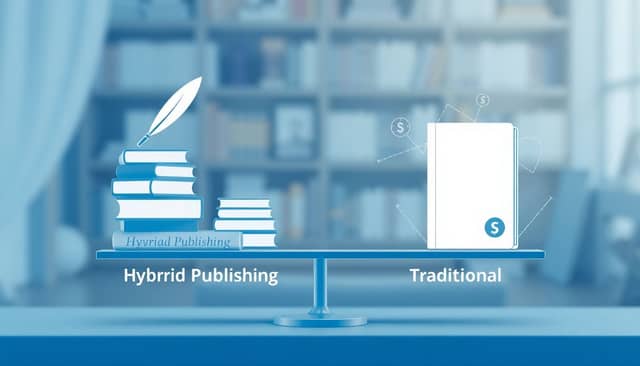Table of Contents
If you’ve ever thought regular publishing seems too hard but doing it all yourself sounds overwhelming, I hear ya. Hybrid publishing can feel confusing at first glance, and let’s be real—it’s tricky knowing if it’s a good deal or just throwing money away.
No worries though; stick around and I’ll break it down for you step by step. By the end, you’ll see if hybrid publishing fits your book goals and actually makes financial sense for you.
Ready to clear things up? Let’s go!
Key Takeaways
- Hybrid publishing mixes aspects of traditional and self-publishing—you pay upfront costs, but professionals handle editing, design, and distribution.
- While upfront fees can be significant (sometimes around $25,000), royalties are typically higher (up to 85%), increasing your earning potential per sale.
- It’s ideal if you value professional guidance but prefer quicker release times than traditional routes offer.
- Always research publishers carefully—check reputations, fees, services included, and talk to other authors first.
- Hybrid publishing works best for authors with an established audience or niche subject matter who want professional quality without independent publishing struggles.

Step 1: Understand What Hybrid Publishing Is
Hybrid publishing blends elements of traditional and self-publishing, where authors bear financial costs but collaborate with professional publishers who handle editing, design, and distribution.
Think of it this way—you’re splitting the work and risks between yourself and an established publisher.
This means you’ll have professional guidance and access to publishing networks, but you’ll pay upfront fees instead of receiving an advance from the publisher.
For example, a hybrid publisher like Greenleaf Book Group selects manuscripts they consider marketable, then provides professional support in exchange for author-funded production packages.
Authors often find hybrid publishing useful when traditional publishers aren’t biting, yet they still want a professional team to help with quality control, distribution channels, and branding.
Hybrid publishers usually vet submissions rigorously, ensuring quality, which can boost credibility compared to pure self-publishing options.
Step 2: Learn How Hybrid Publishing Works
Hybrid publishing starts by reviewing your manuscript to ensure it meets their quality standards and has market potential—straightforward enough!
Once you’ve passed that hurdle, the publisher works alongside you on editing, cover design, formatting, and setting up distribution to online and traditional retailers.
You pay an upfront package fee that covers these services, and in return, receive much higher royalty rates compared to traditional publishing deals.
For instance, Amplify Publishing offers up to 85% royalties (way higher than most traditional deals), making it appealing despite upfront costs.
From there, you can be involved as much (or as little) as you prefer—approving designs, discussing marketing strategies, or leaving logistical details to the publishing team.
The finished product is professionally produced, available through various channels, including Amazon, Barnes & Noble, and independent bookstores.
Another bonus—unlike self-publishing, you don’t have to tackle complex details like how to get your book published without an agent alone, since hybrid publishers bring experienced teams to expedite this process.
Step 3: Know the Cost of Hybrid Publishing
Alright, let’s talk numbers: hybrid publishing does involve upfront investments, usually higher than typical self-publishing due to the professional services provided.
A reputable hybrid publisher, like Forbes Books, might charge around $25,000 for comprehensive services, which can include everything from ghostwriting support and creative design to broad online retail distribution.
Cost factors range widely depending on your chosen service package, complexity of your manuscript, book genre, production specs (hardcover, audiobook, full-color images, etc.), and marketing plans.
Remember, quality doesn’t come cheap, but the trade-off is the potential for increased professionalism, market credibility, and reach.
So before jumping in, thoroughly research hybrid publishers, compare packages, scope out examples such as Greenleaf or Amplify, and clearly list out exactly which services you’re getting for your dollars.
It’s also important to calculate your profit potential—consider sales goals against your initial expenses to make sure the math makes sense for your particular project.
For a cost-effective method of hybrid or independent publishing, explore options like ebooks or publishing straightforward low-content formats such as journals, planners, or even learning how to publish a coloring book, allowing lower startup costs and quicker returns.

Step 4: Compare Hybrid Publishing vs. Traditional and Self-Publishing
If you’re thinking hybrid publishing sounds interesting, you’re probably wondering how exactly it stacks up against traditional and self-publishing.
With traditional publishing, publishers handle everything from editing and design to distribution and marketing, offering authors advances and paying lower royalties (often around 10-15%).
It’s a long road—querying agents, hoping a publisher bites—but the prestige and minimal financial upfront investment are big pluses.
In contrast, self-publishing gives authors complete independence and control, but it also means you’re responsible for all upfront expenses, book design, marketing efforts, and distribution, which can get overwhelming and costly if you’re new to publishing.
Now, hybrid publishing is a middle ground, blending traditional publishing support—professional editing, distribution chains, credible branding—with the upfront costs typically seen in self-publishing, though your royalties tend to be much higher, such as the 85% offered by Amplify Publishing.
So, here’s a tip: Weigh what’s more important to you—control, earnings per sale, upfront investment, or access to established industry distribution and credibility—then see where hybrid publishing falls on your personal checklist.
If your gut says hybrid may be right but you’re uncertain, check out some case studies from successful hybrid authors.
Step 5: Review Examples of Hybrid Publishing Companies
Wondering who exactly does hybrid publishing really well? Let’s look at some real examples:
First up, Greenleaf Book Group has been around for over 25 years, boasting more than 45 Wall Street Journal and New York Times bestsellers they’ve published—that’s some serious credibility.
Then there’s Forbes Books, part of the famous Forbes brand, known for comprehensive publishing packages (around $25,000), and known especially for business-minded authors who want solid branding and marketing boost.
Morgan James Publishing is another reputable hybrid publisher—you’ll find them offering a partnership model that provides generous royalties (between 20-50%), professional marketing campaigns, and handy distribution through well-known channels.
Before you leap into any agreement, check the publisher thoroughly—look at their previously published books, talk to other authors who’ve worked with them, and always read the fine print closely concerning royalty details and service fees.
Step 6: Check Common Hybrid Publishing Services
So, what’s really included when you sign with a hybrid publisher?
Typically, you’ll get professional editing (from copyediting to heavy developmental edits), book design and formatting (cover and interior), printing management, ebook and audiobook productions, and distribution into online and physical bookstore channels.
Marketing services vary widely—from basic marketing strategies to comprehensive author branding and media campaigns—depending on your budget and the publisher.
But watch out: not all hybrid publishers offer precisely the same services, so ask clearly what’s included in each package.
Pro tip: Compare what hybrid publishers offer against your own needs and against what you could realistically handle yourself using self-publishing platforms.
If certain hybrid publishers are pricey, it might make sense to find freelance editors, designers, or marketing specialists instead.
Step 7: Look into the Pros of Hybrid Publishing
Is hybrid publishing worth the hype? Here are some benefits that might tip you toward it:
Firstly, access to professional support: experienced publishing teams guide you every step of the way, enhancing quality and marketability.
Secondly, better royalties: hybrids often offer much higher royalty percentages like Amplify’s 85% compared to traditional deals averaging just 10-15%.
Thirdly, credibility matters: reputable hybrid publishers vet manuscripts, producing high-quality books with proven track records like Greenleaf’s bestsellers, boosting author reputation and distribution reach.
Lastly, quicker turnaround than traditional publishing can get your book out faster to capitalize on market trends (perfect if you’ve been writing in the booming romantasy genre that’s driving massive sales thanks to TikTok’s BookTok craze).
Step 8: Be Aware of the Cons of Hybrid Publishing
Okay, friend—there’s also the other side of the coin:
Biggest con? Upfront costs—hybrid publishing can significantly dent your wallet (remember that Forbes Books’ $25,000 fee?), particularly without the guaranteed returns of a traditional book deal.
Next up is risk—if your book doesn’t sell well, recouping your investment can be challenging, so crunch those numbers thoroughly!
And quality varies widely among hybrids; not all offer the stellar professional standards you’re after, and occasionally, unscrupulous businesses claim they’re hybrids just to get authors’ initial investments.
Always research thoroughly, check reviews, ask other authors, and consult resources like Writer Beware to avoid potential scams.
Step 9: Identify Who Should Use Hybrid Publishing
Hybrid publishing isn’t one-size-fits-all, but here’s who usually benefits most:
Authors with established platforms (coaches, industry experts, entrepreneurs) who can predict book sales based on their audience size often use hybrids to expand their brand and credibility.
Writers whose books don’t neatly fit traditional publisher moulds—such as niche genres or extremely timely topics—might get advantages from hybrid’s quick production timelines.
Also, folks who neither desire nor have time to oversee self-publishing and want a professional hand but are tired dealing with rejections in traditional publisher slush piles find hybrid attractive.
Step 10: Decide if Hybrid Publishing is Right for You
So, should you go hybrid? Here’s your quick checklist to decide:
- Do you value professional support to ensure quality?
- Are you comfortable investing money upfront without guarantees?
- Does getting higher royalties than traditionally published authors appeal greatly?
- Do you have a specific, timely publishing goal that makes traditional publishing too slow?
- Would distribution through physical and digital bookstores significantly boost your book’s visibility and potential sales?
Answer yes to most? You’re probably a great candidate for hybrid publishing.
If you still aren’t sure, chat with authors who’ve chosen hybrid paths or glance at some alternatives—maybe even explore how to get a book published without an agent for another approach.
Your book deserves the right choice, so take your time, reflect, and pick the route that’ll bring your unique manuscript successfully to its readers!
FAQs
Hybrid publishing blends features of both traditional and self-publishing. Authors typically invest upfront, receive higher royalty rates, and benefit from professional publishing services, such as editing, design, marketing, and distribution offered by the company.
Costs for hybrid publishing typically range from a few thousand to tens of thousands of dollars, based on the level of services selected and the publisher’s reputation. Authors generally pay for publishing packages that cover editing, designing, and marketing.
Hybrid publishers require authors to invest financially upfront, unlike traditional publishers who bear publishing costs themselves. Authors who choose hybrid publishing have more creative control, higher royalty percentages, and retain full rights to their work.
Hybrid publishing suits authors seeking professional publishing services and distribution support while keeping control over content and earning higher royalties. It’s beneficial for authors ready to invest money upfront to achieve a professionally produced, marketable book.



